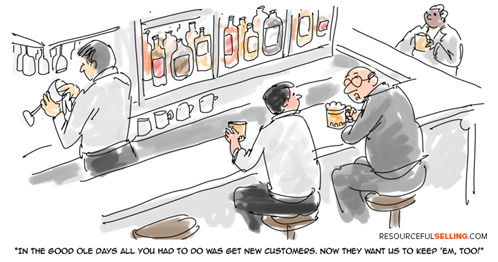Digital Maturity for the Modern B2B Sales Organization – Are you ready?

There can be no underestimating the extent to which digital technologies have disrupted the B2B ecosystem and forced organizations to adapt their operations quickly. Faced with a radically changing marketplace, B2B companies are racing to understand how to transform themselves for the digital era.
They know that they have to change but the idea of B2B digital transformation has been framed as e-commerce, but actually we know from experience that B2B companies are not all ready to do that leap in one fell go as their digital maturity isn't at level that will allow it, rather we have seen many transform step by step, and this evolutionary approach may ultimately never be about full-blown e-commerce, though that option is still there if a businesses reaches a certain level of digital maturity.
Sales and marketing departments have been particularly affected, as their traditional means of selling, reaching out to new customers, and processing purchases have changed beyond all recognition. With this in mind, we've compiled this guide to five major changes your B2B business should consider implementing during your digital transformation process. Throughout the guide, we'll also be placing a particular emphasis on the concept of digital maturity.
What is digital maturity?
Digital maturity is a business's capacity to respond to technological innovations and developments . In other words, it's the ability to adapt to technological disruption. While digital transformation and digital maturity are related concepts, they are not the same thing. You will not be able to create a digital maturity framework without some definition and insight in what it is.
Digital transformation is all about taking manual processes and replacing them with digital equivalents, whereas digital maturity is concerned with a company's flexibility. You can dedicate years to implementing your digital transformation strategy, but if you're no better prepared for future technological disruption at the end of it, you're not any more digitally mature.
When considering the relationship between the two concepts, it’s a good idea to contrast questions you may ask when attempting to measure your transformation and digital maturity.
| Digital Transformation | Digital Maturity |
| Is your new, digital human resources system in place and ready for implementation? | Are your staff ready to shift to a new digital system, and do they have the digital skills to learn the new system on their own? |
| How many customers are using your new B2B sales portal? | How are customers using your new B2B sales portal? Which features are popular and which are barely used? Are customers able to self-serve, are you meeting their expectations of finding what they want in the portal. |
| What customer data are you collecting? How can we increase data harvesting efforts? | Do employees understand what collected customer data means and how to leverage that data to inform decision-making? Do your sales people monitor and track customer activity online, and crucially do they know when to intervene in the sales process? |
Why is digital maturity necessary?
Though it's a relatively new concept, digital maturity is just as important as digital transformation. After all, what's the use of investing large sums in digital technology if your organization cannot respond to the next big digital leap or disruptive event.
Consequently, the five changes we've listed below are designed to help you achieve your digital transformation goals while also enabling you to digitally mature as an organization. They can act as a digital maturity framework, sparking the change necessary to overcome future challenges.
1. Uniting Sales and Marketing in one team
Historically, Sales and Marketing teams have worked separately, especially in B2B companies. In organizations that aren't digitally mature, the two teams operate in silos. In other words, data sharing, collaboration, and cooperation are all difficult. There's often a significant amount of friction and competition between the two departments, and they're regularly working towards very different goals and strategies.
In the past, sales were seen as the dominant force in any B2B organization. They held the keys to the kingdom. Today, the marketing team is just as important. Responsible for the entire customer contact process - from early engagement to post-purchase interactions - they play a vital role in managing all significant touchpoints.
Ultimately, merging sales and marketing functions into one global team with the same leadership will give it the best chance to transform. This is because sales and marketing roles are so intertwined and interdependent that it makes little sense to separate them. B2B sales and marketing teams need to provide personalized content for buyers and sales become trusted advisers, giving answers to questions that buyers are asking at different stages of the buying cycle.
Marketing generates interest in your products. Sales converts that interest into revenue. Each is unable to operate without the other. So why persist with an organizational structure that separates them and introduces unnecessary friction? Uniting both teams is a pathway to digital maturity for your organization.
2. Adopting an approach driven by 'Customer Success'
The sheer amount of choice on offer in modern markets means that the balance of power has tipped firmly in favor of the customer. If your customer experience is unsatisfactory, customers switch to a competitor that does things better. As a result, Sales is now more concerned with being empathetic, understanding the customer, and working to ensure customer satisfaction across all interactions with your brand.
The idea of “customer success” emerged several years ago and quickly gained traction, evolving into a new discipline with client relationship management. It deals with ensuring the customer successfully uses your products and services to achieve their desired goals. Customer success helps companies better understand the customer experience - the way customers use your products or services and the value they feel they derive from them, in particular.
In the modern sales organization, this mindset needs to be extended to all functions to guarantee the best customer experience. Aside from pricing, customer experience is now the number one factor for B2B buyers when choosing providers. Your business needs to ensure that it's working to maximize the value your customers feel they get from your products.
3. No More ABC Mottos
As we’ve already mentioned, there was a time when sales reps lorded it over the office because they were so vitally important to generating revenue. Though their importance has not diminished, other teams within your organization have stepped up and become equally intrinsic to the business’ success.
Maybe you will have heard the ABC sales mantra - “Always Be Closing.” It's a common cliché and was a motivator for many B2B Sales Teams. Today, the culture of closing at all costs is a relic of a bygone era. This era - which is best represented by the superhero account exec (think Don Draper in Mad Men) who closes the deal no matter what - is most certainly over.
Though closing remains incredibly important, it is no longer viewed as the critical moment in the customer journey. Instead, we recognize the importance of every little nudge, hint, or interaction that made the purchase or repurchase possible. This idea carries even more weight in the B2B market, where repurchases are potentially more important than closing on that first sell.
In some ways, the entire model has been tipped on its head. The sale is now a buy. The transaction is closed by the customer, not the sales rep. Consequently, the sales team (and its digital companions) must be available to guide at every step of the process, ensuring the customer has all the elements necessary to come to a decision.
Every B2B business is different and at a different stage of digital maturity but all buyers want detailed and up-to-date information about your products as well as their price and availability. Even if you do not sell online, can you give your customers the data that matter most to them apart from the product information itself: how much will it cost and how soon can I have it?
4. Transforming Sales Remuneration
Traditionally, sales teams have worked on variable remuneration, and their wages were indexed against the revenue they generate from closing a sale. They earn commission and operate in a similar way to an independent reseller. This arrangement has been a pillar of sales organizations for decades. This approach creates a system in which sales owns the customer. Sales reps are paid on their individual performance and how much revenue they can generate from the customers allocated to them.
This type of arrangement is no longer productive in a business model that takes ownership of the customer away from sales reps and puts it in the hands of the entire organization. Salespeople are still vital in the modern sales organization, but they don't run the show anymore.
Instead, several people work on the same opportunity. A direct consequence of this transformation is that the remuneration model needs to change. It can no longer center on the salesperson’s individual role in generating revenue because they no longer (if they ever did) generate revenue individually.
Gartner has recently stated that "sales leaders will have to rethink their role substantially. Too many sales leaders today perceive themselves to be the leader of sellers rather than the leaders of selling."
The report went on to add that: "Ultimately, sales is about selling. Irrespective of whether the role of human involvement in sales decreases over time, selling must still happen one way or another; the channel (human versus digital) is merely the means, not the end."
Sales teams can now leverage data to anticipate demands and developments which the B2B buyer himself may not have spotted. This is sales without selling, where the rep works in
collaboration with the customer to create business value – for the customer. This shift in emphasis from B2B to B4B is part-cultural, part-technological, as always in as a company grows in its digital maturity.
5. Putting Data Front and Center
Finally, B2B organizations need to make radical changes in how they collect, analyze, and leverage data. It's not a stretch to say that the success of the modern sales organization will largely depend on its mastery of customer data. This includes how it captures customer data, understands it, and uses it to deliver superior buying experiences, whether by automating processes or enabling salespersons.
As a result, the whole marketing and sales organization needs to realize and embrace the role of data. From accepting the importance of data quality when using Martech and CRM tools to understanding the complex and creative process of building innovative buyer journeys, data will determine your business’s ability to offer an excellent customer experience.
Conclusion
If you are a B2B company just beginning the digital transformation process, it would be a mistake to think technology is the silver bullet you're looking for. Technology is critical, but the organization, its sales strategy, and culture are equally important. That's what's meant by digital maturity.
While our focus at Ibexa is to provide the best Digital Experience Platform (DXP) technology to digitalize B2B sales channels, we're just as passionate about organization, culture, and strategy as we are about the technology itself. Please reach out; we'd love to meet and discuss both your transformation and ours, as we believe we're headed in a very similar direction!
In the meantime why not download our ebook: Ibexa Methodology: The Five Steps to Digital Maturity: How managing product information and content combined with commerce is essential for B2B success. The eBooks gives them a digital maturity framework, and shows how B2B businesses can transform realistically, step by step and highlights the functionalities of our platform that are instrumental in helping you capture more and more of the granular complexity of how you do business.
Credit for both cartoons: Ben Stroup via www.business2community.com
1 Gartner. 5 Ways the Future of B2B Buying Will Rewrite the Rules of Effective Selling. Published 4 August 2020 By Brent Adamson, Nick Toman
Covid has been a moment of truth for B2B. Lanching digital channels is the way forward.
How B2B Companies Can Diversify Their Digital Sales Channels
Are you concerned about losing your current strong sales relationships if you move to digital, and how do you position yourself within the complex dynamic between the products that you sell and the digital channels that best serve your purpose: to sell more?
This eBook addresses how B2B businesses can evaluate their options, and to focus minds on the implications of diversifying their digital sales channels.



